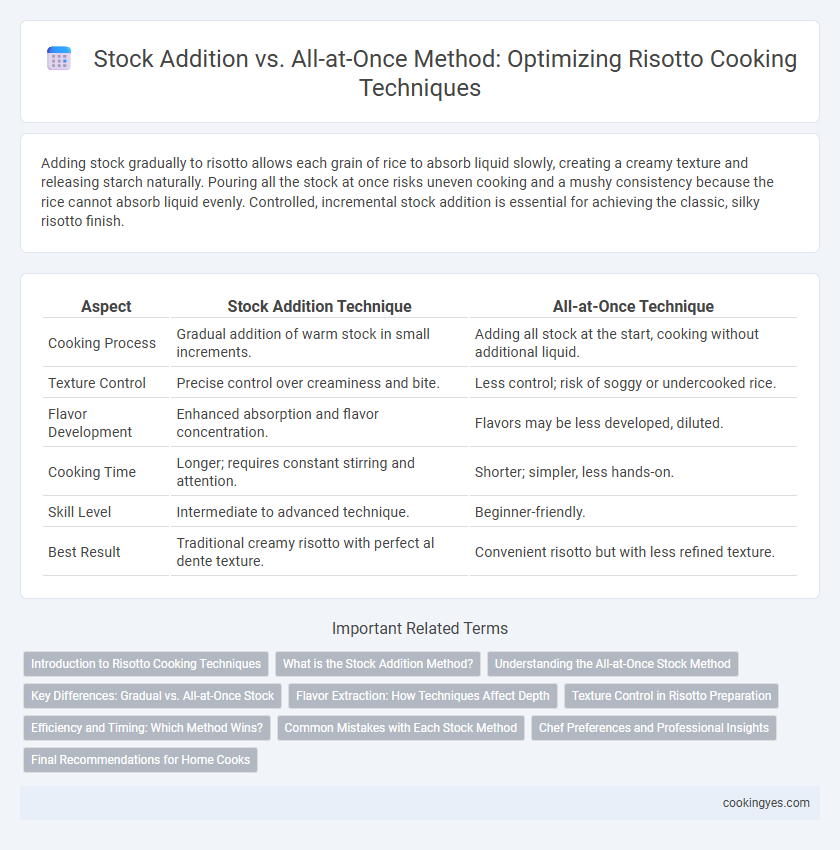Adding stock gradually to risotto allows each grain of rice to absorb liquid slowly, creating a creamy texture and releasing starch naturally. Pouring all the stock at once risks uneven cooking and a mushy consistency because the rice cannot absorb liquid evenly. Controlled, incremental stock addition is essential for achieving the classic, silky risotto finish.
Table of Comparison
| Aspect | Stock Addition Technique | All-at-Once Technique |
|---|---|---|
| Cooking Process | Gradual addition of warm stock in small increments. | Adding all stock at the start, cooking without additional liquid. |
| Texture Control | Precise control over creaminess and bite. | Less control; risk of soggy or undercooked rice. |
| Flavor Development | Enhanced absorption and flavor concentration. | Flavors may be less developed, diluted. |
| Cooking Time | Longer; requires constant stirring and attention. | Shorter; simpler, less hands-on. |
| Skill Level | Intermediate to advanced technique. | Beginner-friendly. |
| Best Result | Traditional creamy risotto with perfect al dente texture. | Convenient risotto but with less refined texture. |
Introduction to Risotto Cooking Techniques
Gradually adding warm stock to risotto allows the rice to absorb liquid evenly, releasing its starch for a creamy texture and improved flavor development. Pouring stock all at once risks uneven cooking and a less creamy consistency, as the rice cannot properly absorb the liquid or release starch. Mastering the traditional ladle-by-ladle stock addition is key to achieving perfectly cooked, silky risotto.
What is the Stock Addition Method?
The Stock Addition Method in risotto preparation involves gradually adding warm stock to the rice in small increments while continuously stirring, allowing the grains to absorb liquid slowly and release their starch for a creamy texture. This technique contrasts with the all-at-once method, which adds all the stock at once, often resulting in less control over consistency and a drier finish. Consistent stirring during the stock addition enhances the risotto's rich, velvety mouthfeel and promotes even cooking of the Arborio or Carnaroli rice varieties.
Understanding the All-at-Once Stock Method
The all-at-once stock method for risotto involves adding the entire quantity of broth to the rice at the beginning of cooking, creating a consistent moisture level that allows the rice to absorb liquid evenly. This technique reduces the need for constant stirring, resulting in a creamier texture with less active attention compared to the traditional gradual stock addition. The all-at-once method is ideal for quicker risotto preparation while maintaining the essential creamy consistency characteristic of classic risotto dishes.
Key Differences: Gradual vs. All-at-Once Stock
Gradual stock addition in risotto involves pouring warm broth in small increments, allowing each portion to be absorbed fully before adding more, which enhances the creaminess and depth of flavor by gradually releasing starch from the rice. In contrast, the all-at-once method adds the entire stock at the beginning, resulting in a faster cook time but often a less creamy texture and less control over the final consistency. The key difference lies in texture and flavor development: gradual addition promotes a silkier, richer risotto, while all-at-once stock yields a simpler, less nuanced dish.
Flavor Extraction: How Techniques Affect Depth
Gradually adding stock during risotto cooking allows rice to release starch slowly, creating a creamy texture and deep, layered flavors. Pouring all the stock at once prevents proper starch release, resulting in a less velvety mouthfeel and flatter taste. Controlled stock absorption enhances the savory complexity and richness essential to traditional risotto.
Texture Control in Risotto Preparation
Gradual stock addition in risotto allows precise control over starch release, resulting in a creamy and smooth texture. Adding all stock at once can cause uneven absorption, leading to a less cohesive and occasionally grainy risotto. Mastering incremental ladling promotes optimal rice creaminess and distinct grain integrity.
Efficiency and Timing: Which Method Wins?
Adding stock gradually during risotto preparation allows precise control over starch release and rice texture, leading to a creamy consistency and even cooking. The all-at-once method reduces stirring time and speeds up the process but risks uneven absorption and less creamy results. Efficiency and timing favor the traditional gradual addition for superior texture despite requiring more attention.
Common Mistakes with Each Stock Method
Adding stock gradually to risotto prevents clumping and ensures each grain absorbs liquid evenly, avoiding mushy texture often caused by pouring all stock at once. Common mistakes with all-at-once stock addition include uneven cooking and reduced creaminess due to inability to properly release starch. Gradual stock incorporation requires patience but delivers the signature velvety consistency essential for authentic risotto.
Chef Preferences and Professional Insights
Professional chefs prefer adding stock gradually when making risotto to achieve maximum creaminess and ideal texture, as this method allows precise absorption and flavor layering. The all-at-once technique, though faster, often sacrifices the risotto's characteristic al dente bite and nuanced taste development. Culinary experts emphasize that controlled ladling of warm stock enhances starch release, resulting in a richer, silkier consistency favored in fine dining.
Final Recommendations for Home Cooks
For home cooks aiming to master risotto, adding stock gradually allows better control over texture and starch release, resulting in a creamy consistency. Pouring all the stock at once increases the risk of uneven cooking and a less cohesive final dish. Slow, attentive stock incorporation is key to achieving authentic, restaurant-quality risotto at home.
Stock addition vs all-at-once for risotto technique Infographic

 cookingyes.com
cookingyes.com